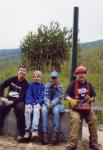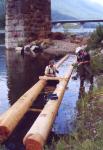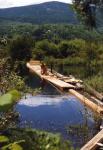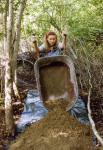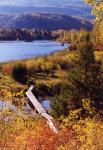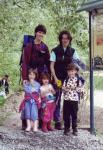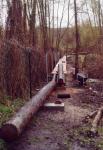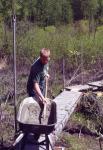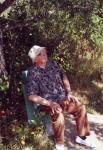 | |||||||||||||||
WALDIE ISLAND TRAIL CONSTRUCTION HISTORYThe concept for Waldie Island Trail was a spinoff from my earlier efforts with others to save the pedestrian walkway on the CPR bridge from demolition. With the assistance of Byng Giraud, I developed a presentation based on the historic and ecological values of the landscape now traversed by the trail. That presentation was helpful in saving the footbridge and it formed the basis for a project funding proposal which I developed for the Friends of Parks and Trails Society in 1995. Late in the year the base funding was secured, and I commenced with detailed planning and site investigation work. High water levels in the winter allowed me to establish the highest possible ground which the trail could follow.Research for sign development followed in early 1996. I soon realized that the two interpretive panels which could be supported with the base funding would be inadequate to cover all the pertinent historic themes and therefore I decided to seek corporate support by offering sponsorship for individual panels for the price of $ 2,000 apiece. I am proud to state that no one turned me down, and the very welcome corporate support effectively doubled my original budget. Celgar Pulp also donated used pipe which allowed me to fabricate all the sign frame components. With this new funding in mind, I developed and sent to production six interpretive panels, with Leni Normington (Street Front Graphics) working out the basic graphic design elements.
Actual work at the site commenced in April of 1996. With the help of very young friends and donated materials I constructed a raft by means of which we moved over 3 cubic meters of gravel from an upstream source to the muddy bridge site. Nine raft trips were required to secure an adequate supply for the required concrete work. At the beginning of May I hired a crew of 3 and together we rushed ahead with the construction of the footings and abutments for the bridge during the 3 week low-water window which remained. I considered two designs for the bridge, but in the end settled for a model which adjusts itself to the prevailing water level or rests on low piers in which guide posts are embedded. Materials, mixer, and generator were delivered by Kootenay Valley Railway on the nearby rails. Once the bridge piers and abutments were completed, work shifted to clearing the trail routes. Castlegar Public Works supplied several loads of road gravel to the nearest spot on the lagoon berm; it was transferred downhill and hauled to the required location by wheelbarrow. It was used to elevate the trail out of the muddy ground and to form a reasonably consolidated surface. A sheet of 6 mil polyethylene was used as ground material to prevent vegetation from growing through.
While the crew worked on surfacing the trail, I concentrated on preparing the materials for the bridge. Lumber donated by Kalesnikoff Lumber Co. was precut at my home shop, and the two new 50 foot cedar poles donated by West Kootenay Power were precut by me in the company yard and brought to the CPR bridge site by company equipment. Once the prepared poles were afloat, the bridge centre span was assembled from the precut components and towed to the bridge location by boat. Here it was secured to the guide posts by prefabricated coupling collars. By now the river was in full flood and the tops of the guide posts were in the danger of being submerged and had to be extended. A railway delivery of the precut decking and ramp components allowed me to finish the bridge over a weekend under the threat of ever-rising waters. When the water level receded we proceeded to construct a long and sinuous boardwalk across the lowest ground which was subject to prolonged seasonal flooding. It was constructed behind natural vegetative screening so that the disturbance to the wildlife along the shoreline and on Waldie Island would be minimal. The boardwalk segments were assembled from logs caught off the river and floated into position, and 2 foot mill-ends which I obtained from the chipper conveyor at the Pope and Talbot sawmill. Used pipe donated by Castlegar Public Works was driven into the muddy ground and acted to restrain the boardwalk when afloat. Three benches were constructed on concrete foundations. Six metal sign frames were assembled from components which I had fabricated at my home shop and subsequently had powder-coated. For durability, they were cemented into place. The sign panels themselves were fitted with Plexiglass protective facings and installed in the frames. The last development was the placement of the metal interpretive stop markers, and the sturdy metal gate posts.
The project was completed within budget. Waldie Island Trail was officially opened on the BC Rivers Day weekend, Sept. 28/29 1996. Subsequent Work Early wet snowfalls in the fall of 1996 completelly flattened and killed most of the brushwood that had been growing adjacent to the boardwalks, and next year's flooding shifted the boardwalk sections, creating major problems. The original boardwalks became a headache as they had to be repaired after every flooding event. A subsequent wind storm brought down a huge cottonwood and demolished the small bridge on the middle loop beyond easy repair. Eventually the mid-loop would have to be abandoned, and the boardwalks would have to be reconstructed to a more durable standard. In the spring of 1997 I produced a brochure for Waldie Island Trail, with an explanation of all the numbered stops and full sponsor acknowledgements. For the back side of the brochure I adapted my large hand-drawn map which I had developed to promote the Waldie Project. As both Waldie Island Trail trail-heads were exposed to vandalism, it was decided to run off copies for distribution at the Castlegar Museum and the Chamber of Commerce. Vandalism problems and other natural disasters kept me busy. In 1997 most of the Plexiglass panels were smashed and I had to remove all the signs in order to replace the protective panels with the more durable Lexan. All the original corporate sponsors covered the material costs. Late in the year, a segment of the trail was lost as a bank collapsed into the Columbia River, and with the assistance of BC Hydro I built a short bridge across the gap. In the spring of 1998 BC Hydro funded an expensive repair which involved reconstruction of the bank and rip-rap protection. I obtained the appropriate permits and prepared engineering drawings so that the work could proceed. Late that year a similar but much larger collapse occurred slightly downstream, just under the Waldie Mill sign. In the spring of 1999 BC Hydro teamed up with the City of Castlegar, Columbia Power Corporation, and Peter Kiewit Sons Co. to get the job done. With the help of volunteers I subsequently seeded the area and planted several trees.
On two occasions, district Cubs, Scouts, and Beavers planted over 2,000 trees along the trail; from this massive effort, only about 15 % survived. In the summer of 2000 I started with the construction of a new boardwalk which followed the highest possible ground so that passage through the flooded wetland was possible under almost all river flow regimes. The following year, a new funding grant and donated materials allowed me to rebuild the original lower boardwalk. The entire boardwalk was jacked up and blocked so that concrete footings could be poured underneath it and the guide posts were embedded into the concrete. New cedar pole stringers were floated into position and coupled to the guide posts and 42 inch cedar decking was installed. Other improvements include an additional sign on native culture funded by Columbia Power Corporation and the construction and installation of a bird observation platform by Peter Kiewit Sons Co. In 2002 the Ministry of Transportation and Highways commenced with the process for dismantling the CPR footbridge across the Columbia River. After several meetings with MOTH staff and a study of the engineering recommendations, I recommended to the FPT Society that we accept the removal of the historic footbridge, as there was little hope of raising the nearly .5 million dollars required to replace it. As a mitigative measure. MOTH funded the development of an extension trail from the train bridge to the Robson-Castlegar highway bridge, and a right-of-way was secured for this new riverside trail segment.
My dreams for the area were fulfilled when in the summer of 2002 Waldie Island was purchased by the Nature Trust of B.C., with the help of several stakeholders, and turned into a preserve for great blue herons. With funding from the Nature Trust I developed and installed several signs on the island and adjacent shore to sensitize users of the area to the prevailing ecological values. A formal dedication ceremony was held at the site on June 14 2003, in association with a regional conference of Ducks Unlimited Canada, a major sponsor of the acquisition. In the summer of 2004 I developed (with Linda Van Damme) a sign on the biology of the great blue herons and installed it just downstream of the bridge. It was funded by BC Hydro. The Waldie Island Trail Project thus incorporates the first and the last work which I did as Trail Coordinator for the Friends of Parks and Trails Society, a position I held over a span of ten years. The Project was the most complex, and - in many ways - it remains for me the most rewarding. Chronology & Acknowledgments 1995 Planning, site studies and proposal development. 1996 Implementation of the Waldie Island Trail Project.
Paid crew: Wade Forester, Mandy Giraud, Cory Martinson Volunteers: Steven Rigby, Donny Osachoff, Graham Campbell, Bob McBain, Peter Wood, Gordon Gibson/Len Dunsford and Selkirk College RFW students.
Special thanks must be extended to Moira Paterson of BC Hydro for pushing this project through.
Paid crew: Aaron Retzlaff Volunteers: Peter Wood, Byng Giraud
Paid crew: Kevin James, Kyle Levy Acquisition of Waldie Island by the Nature Trust of B.C. Major Support: Columbia Basin Fish & Wildlife Compensation Program; Ducks Unlimited Canada; Columbia Basin Trust; Nature Trust of B.C.; West Kootenay Naturalists, working with BC Hydro.
Paid crew: Sonny Zlotnik, Justin Dexter Volunteer: Kenji Kitagawa Waldie Island purchase dedication ceremony (June 14 2003)
Volunteer: Linda VanDamme | |||||||||||||||
|
All rights reserved. Information is provided for personal use only. Use in any other application without permission is forbidden. |

